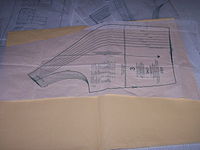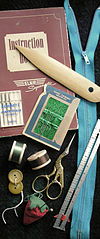- Pattern (sewing)
-
In sewing and fashion design, a pattern is an original garment from which other garments of a similar style are copied, or the paper or cardboard templates from which the parts of a garment are traced onto fabric before cutting out and assembling (sometimes called paper patterns).
Patternmaking, pattern making or pattern cutting is the art of designing patterns.
A custom-fitted basic pattern from which patterns for many different styles can be created is called a sloper or block.
Contents
Pattern making
A custom dressmaker frequently employs one of three pattern creation methods. The flat-pattern method begins with the creation of a sloper or block, a basic pattern for a fitted, jewel-neck bodice and narrow skirt, made to the wearer's measurements. The sloper is usually made of lightweight cardboard or tagboard, without seam allowances or style details. Once the shape of the sloper has been refined by making a series of mock-up garments called toiles (UK) or muslins (US), the final sloper can be used in turn to create patterns for many styles of garments with varying necklines, sleeves, dart placements, and so on.
Although it is also used for women's' clothing, the drafting method is more commonly employed in men's garments and involves drafting a pattern directly onto pattern paper using a variety of straightedges and curves.
The pattern draping method is used for more elaborate and unique designs that are hard to obtain through the flat pattern method. This is because it is nearly impossible to account for the way a fabric will drape or hang on the body without an actual 3-dimensional test run. It involves creating a muslin mock-up pattern by pinning fabric directly on a dress form, then transferring the muslin outline and markings onto a paper pattern or using the muslin as the pattern itself.
Pattern grading
Pattern grading is an essential part of pattern making. It decides how patterns increase or decrease sizes. According to countries, pattern grading includes USA's, EUR's, UK's, and CHN's.Generally, pattern grading adjusts for people of different ages and genders. The fabric type also influences the pattern grading standards.[1] And marker makings are the actual full size print out of how the styles are cut on the fabric. The cost of pattern grading is incomplete without considering marker making.[2]
Patterns for home sewing
Home sewing patterns are generally printed on tissue paper and sold in packets containing sewing instructions and suggestions for fabric and trim. Modern patterns are available in a wide range of prices, sizes, styles, and sewing skill levels, to meet the needs of consumers.
Home sewing patterns are graded, that is, redrawn to fit larger and smaller sizes than the original design. Ebenezer Butterick invented the commercially produced graded home sewing pattern in 1863 (based on grading systems used by Victorian tailors), originally selling hand-drawn patterns for men's and boys' clothing. In 1866, Butterick added patterns for women's clothing, which remains the heart of the home sewing pattern market today.
There are some applications today that enable a home sewer to customize a computerized pattern to fit her body measurements and or body shape. The 3D technology enables the home sewer to see a virtual simulation of the final garment as it will appear on her. This reduces the Time-to-Market as well as the number of muslins/test garments that are needed.
A variation on the theme was evolved by iconic British brand Clothkits. Clothkits devised ingenious cut and sew clothing kits for home sewing that avoided the need for paper patterns. Rather than using conventional techniques, Clothkits pre-printed fabric with both quirky designs and the pattern lines, to make dressmaking for the novice easier.
Patternmaking books
Patternmaking books are instructional manuals that provide instructions and diagrams on the constructions of various garments. They are primarily for personal and educational purposes.
Evolution of American sewing pattern manufacturers
Four historic American pattern companies still exist:
- Butterick
- McCall's
- Simplicity
- Vogue
William Jennings Demorest and Ellen Louise Demorest began the home sewing pattern industry in 1860 by holding fashion shows in their homes and selling the patterns. This was the beginning of the Mme. Demorests' Emporium of Fashion. They published a magazine, The Mirror of Fashion, which listed hundreds of different patterns, most available in only one size. Patterns were of unprinted paper, cut to shape, and could be purchased "flat" (folded), or, for an additional charge, "made up" (with the separate pieces tacked into position). The latter version was intended to compensate for the absence of detailed instructions.
Ebenezer Butterick launched The Butterick Company in 1863 to create heavy cardboard templates for children's clothing. Butterick's innovation was offering every pattern in a series of standard, graded sizes. Members of his family cut and folded the first patterns that were sold from their home. In 1866 Butterick began manufacturing patterns for women's fashions, and later added some articles of men's clothing. They began publishing the fashion magazine The Delineator in 1873 to publicize their patterns. Their patterns started as unprinted tissue paper cut to shape, folded and held together by a pinned (later pasted-on) label with an image and, later, brief instructions. In the early 1900s they began to use an envelope to hold the pattern. In the late 1910s they introduced a separate instruction sheet, called the "Deltor" (from the first three and last three letters of Delineator). In 1948, they purchased two new presses specially designed to print markings directly onto the pattern tissue.
James McCall, a Scottish tailor, established the McCall Pattern Company in 1870 in New York City. Patterns were unprinted until 1919, when they started printing information directly onto the pattern pieces. In the 1920s, selected patterns had full color illustrations on their pattern envelopes. In 1932 they started printing full color illustrations on all pattern envelopes. McCall usually printed the date of release on their envelopes (the only company which consistently did so before mid-century), which makes it easy to date their patterns.
Vogue Pattern Service began in 1899, a spinoff of Vogue Magazine's weekly pattern feature. In 1909 Condé Nast bought Vogue. As a result, Vogue Pattern Company was formed in 1914, and in 1916 Vogue patterns were sold in department stores. In 1961 Condé Nast entered in a licensing agreement with the Butterick Company.
Simplicity Pattern Co. Inc. started producing patterns in 1927. Their goal was to produce an easy-to-use, lower-priced pattern. They were one of the fastest growing pattern companies, opening offices in Canada, London, Australia, and several in the United States. Their patterns are sold in over 60 countries. Their unprinted patterns ended in 1946, and were all printed thereafter.
DuBarry patterns were manufactured by Simplicity from 1931–1940 exclusively for F. W. Woolworth Company.
Hollywood Pattern Company was started by Condé Nast in 1932. They were known for printing photos of Hollywood stars on some of their patterns, quickly making them very popular. They continued production through the end of World War II.
The New York Pattern Company started in 1932 and continued until the early 1950s. They were unique in that the pattern sleeves had drawn characters rather than photos and the paper used was non-glossy.
Advance began manufacturing patterns in 1933, which was sold exclusively at J. C. Penney Company. The company continued through 1966 until it was sold to Puritan Fashions.
Fitzpatterns.com began offering downloadable sewing patterns in 2004. These consist of full-size patterns to be printed at a copyshop on a large format printer and or in a tiled version that can be printed on an A4 or letter sized printer and sticky taped together.[3][4][5]
Patterns for commercial clothing manufacture
The making of industrial patterns begins with an existing block pattern that most closely resembles the designer's vision. Patterns are cut of oak-tag (manila folder) paper, punched with a hole and stored by hanging with a special hook. The pattern is first checked for accuracy, then it is cut out of sample fabrics and the resulting garment is fit tested. Once the pattern meets the designer's approval, a small production run of selling samples are made and the style is presented to buyers in wholesale markets. Once the style has demonstrated sales potential, the pattern is graded for sizes, usually by computer with an apparel industry specific CAD program. Following grading, the pattern must be vetted; the accuracy of each size and the direct comparison in laying seam lines is done. Once these steps have been followed and any errors corrected, the pattern is approved for production. When the manufacturing company is ready to manufacture the style, all of the sizes of each given pattern piece are arranged into a marker, usually by computer. The marker is then laid on top of the layers of fabric and cut. Once the style has been sold and delivered to stores – and if it proves to be quite popular – the pattern of this style will itself become a block, with subsequent generations of patterns developed from it.
See also
- Sewing
- Tailor
- Dressmaker
- Clothing terminology
- Pattern
- Ellen Louise Demorest
- William Jennings Demorest
- Ebenezer Butterick
References
- ^ Pattern Grading
- ^ Marker marking
- ^ http://www.oystermag.com/features/a-stitch-in-time.html
- ^ http://www.wired.com/techbiz/it/news/2007/01/72517
- ^ http://www.abc.net.au/catapult/stories/s1783065.htm
- Brockman, Helen L. (1965), The Theory of Fashion Design, Wiley
- Aldrich, Winifred (1985), Metric pattern cutting, 4th ed, London: Bell and Hyman, ISBN 1-4051-0278-0
External links
- Butterick's history, from Butterick.com
- The Vintage Fashion Guild
- Patternmaking: Past to Present
- Vintage Patterns Database
Sewing Techniques - Basting
- Cut
- Darning
- Embellishment
- Fabric tube turning
- Facing
- Floating canvas
- Gather
- Godet
- Gore
- Gusset
- Hem
- Heirloom sewing
- Lining
- Pleat
- Ruffle
- Shirring
- Style line
Stitches - Backstitch
- Bar tack
- Blanket
- Buttonhole
- Chain stitch
- Cross-stitch
- Embroidery stitch
- Hemstitch
- List of sewing stitches
- Lockstitch
- Overlock
- Pad stitch
- Running
- Sashiko
- Tack
- Topstitch
- Zigzag
Seams Notions and trims Closures Materials Tools Trades and suppliers - Cloth merchant
- Draper
- Dressmaker
- Haberdasher
- Mercer / Mercery
- Sewing occupations
- Tailor
Sewing machine
manufacturers- Barthélemy Thimonnier
- Bernina
- Brother Industries
- Elias Howe
- Janome
- Merrow
- New Home
- Pfaff
- Sewmor
- Singer
- Tapemaster
- Viking / Husqvarna
- White
Patterns - Butterick
- Clothkits
- McCall's
- Simplicity
Glossary of sewing termsCategories:- Sizes in clothing
- Sewing
- Sewing equipment
- History of clothing (Western fashion)
- History of fashion
Wikimedia Foundation. 2010.



